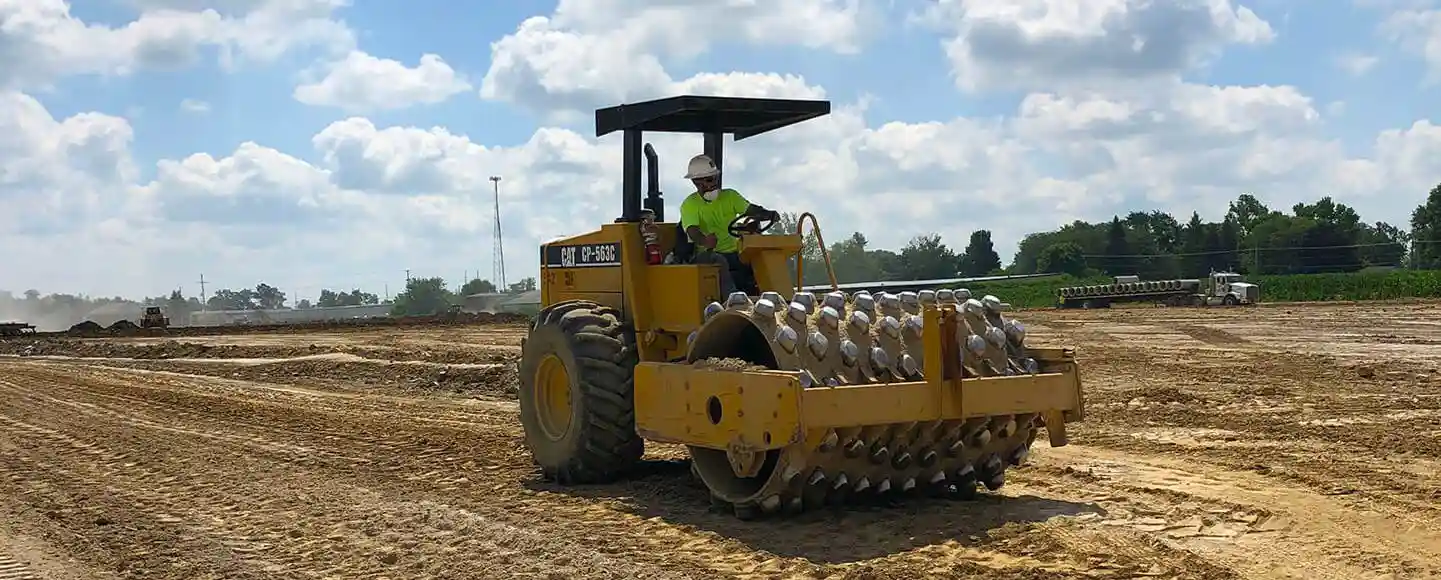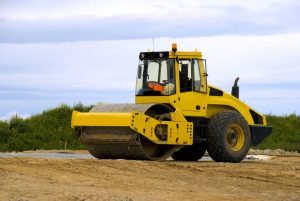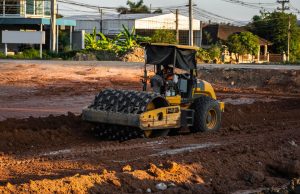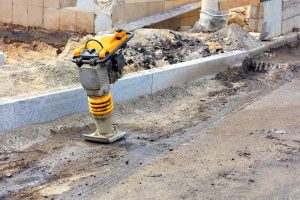The Importance of Soil Compaction in Construction

What is the Objective of Soil Compaction?
Soil compaction is used to densify a soil by reducing the void space, or the amount of air, between soil particles. In other words, soil compaction occurs when soil particles are pressed together to reduce the space between them. The resulting highly compacted soils, with very few spaces, have a higher unit weight than non-compacted soils. Compaction decreases the likelihood of settlement after a building, roadway, runway or parking lot is constructed which could result in premature pavement failure, costly maintenance or repairs. Soil compaction is a crucial part of the construction process as it provides a strong working platform. A strong soil base is the foundation and all other parts of the project depend on its strength and performance, both during construction and once the pavement structure is in place.
Let’s work together.
Types of Soil Compaction Equipment
Compaction equipment has been used in construction since the early 20th century. Steamrollers literally paved the way for today’s modern equipment. Soil compaction equipment comes in a variety of styles with different options such as single or double drums, vibratory mechanisms or dozer blades. All types of compaction equipment help to increase the soil density resulting in an increase in the bearing strength of the soil or material.
- Smooth rollers use static pressure, sometimes in conjunction with vibration and impact, to compact soil. Smooth rollers are not the only type of compactor utilized, but more than likely used in the final compaction step to provide a smooth surface for construction.

- Padfoot and Tamping foot rollers use manipulative force to break the natural bonds between particles for better compaction, especially in cohesive soils. They have tapered feet so they do not fluff the soil decreasing the ability of soil to absorb additional water content should it rain.

- On small to medium soil compaction jobs or mainly gravel soils, pneumatic rollers use staggered rubber tires with varying air pressure where the surface of bladed granular soils needs to be sealed. These units typically have ballast systems that allow weight to be added or decreased as needed to meet compaction goals. Tire pressure can also be altered to help meet compaction goals.

- In confined zones a rammer can be used to densify soil. Tamping rammers are lightweight and portable units that are capable of quickly applying consecutive impacts to a soil.

How to Select Your Soil Compaction Equipment
The type of soil that you are trying to compact plays a large role in selecting the proper compaction equipment in soil compaction construction. Generally, soils can be broken up into three groups: organic soils, coarse-grained and fine-grained. Organic soils are not suitable for compaction and construction purposes so they will not be discussed any further. Coarse-grained soils are essentially granular and can be broken into two subcategories, gravel and sand. In general they are gritty to the touch and do not retain water. Fine-grained soils are cohesive in nature and can be broken into two subcategories, silt and clay. Clay and silt feel smooth when moist and retain relatively high amounts of water. The proper equipment choice for a particular soil type can drastically improve the ending degree of compaction.
Smooth Rollers
Smooth rollers are very effective on granular soils including gravel and sand. Smooth rollers use static pressure, sometimes in conjunction with vibration and impact, to compact soil. Smooth rollers are not the only type of compactor utilized, but more than likely used in the final compaction step to provide a smooth surface for construction.
Padfoot and Tamping foot rollers
Padfoot and Tamping foot rollers can compact soils with more cohesive content. They use manipulative force to break the natural bonds between fine-grained soil particles for better compaction. They have tapered feet so they do not fluff the soil decreasing the ability of soil to absorb additional water content should it rain
Pneumatic rollers
Pneumatic rollers work well on small to medium soil compaction jobs. They use staggered rubber tires with varying air pressure where the surface of bladed granular base materials need to be sealed. Additional weights or ballasts can be added to meet compaction goals.
Tamping rammers
Tamping rammers work very well for small spaces or confined work areas since they are lightweight and portable. They work especially well on cohesive soils.

Soil Compaction in Residential Construction
It does not necessarily take a trained eye to spot the effects of incomplete compaction around houses. Buckling sidewalks and driveways, settling cracks in foundations and puddles in yards resulting from poor drainage are just a few of the common negative results of incomplete or improper soil compaction methods. The minimal cost and effort of compacting soil early in the construction process is an easy way to minimize any effects of settling that would result in unhappy customers down the (hopefully compacted) road. The bearing capacity is a very important measure for load bearing soil and can be increased by compacting the soil. The bearing capacity of a soil is the maximum amount of contact pressure the soil can handle before a shearing. More simply, it is the ability to hold a load, or remain rigid, before soil particles start to slide around each other to accommodate the increased weight. This is especially important for structural pieces such as foundations and footings and slabs such as driveways, sidewalks or steps. Soil should also be compacted after backfilling or anytime in-situ, or “natural state” soil has been disturbed.
What is meant by Soil Compaction?
Soil compaction is the practice of applying mechanical compactive effort to densify a soil by reducing the void space between soil particles. Compaction occurs when particles are pressed together to reduce the air space between them, highly compacted soils contain very few spaces resulting in soil with higher unit weight. Maximum density is achieved at an optimum moisture content, or OMC for short. Maximum dry density (MDD) and OMC are first determined in a laboratory to help provide a target for compaction and water content in the field. This relationship is best displayed using a moisture density curve, also referred to as a compaction curve. A compaction curve can be developed using ASTM 698, commonly known as Proctor testing. Using this method multiple samples are compacted in a repeatable manner into a specified mold by a specifically weighted hammer from a specified height a specific amount of times. A curve, with the apex corresponding to OMC and MDD, is produced by plotting each point. In the field, moisture content and compaction are most often determined using a nuclear gauge. A “one point Proctor” is another common option in many cities and states.
The process of compaction decreases the likelihood of settlement after a building, roadway, runway or parking lot is constructed which could result in premature pavement failure, costly maintenance or repairs. Soil compaction is a crucial part of the construction process as it provides a strong working platform. A strong soil base is the foundation and all other parts of the project depend on its strength. Multiple soil compaction equipment options are available each with their own benefits.
Why is Soil Compaction Important?
Soil compaction is necessary to increase the bearing capacity and stiffness of in-situ (natural state) or chemically modified soils. Compaction increases the shear strength of soils by adding friction from the interlocking of particles. Future settlement of soils is reduced by increasing the stiffness and eliminating voids creating a densified soil. The removal of voids reduces the chance of the soil settling or shrinking or expanding and it decreases water seepage that would lead to deleterious shrinking and swelling soil properties. Shrink / swell properties compromise the pavement structure thereby leading to premature failure of the pavement structure.
What does it mean to have 95 Percent Compaction?
95 percent compaction means that the soil has been compacted to 95 percent of the possible density of the soil through compactive efforts. Maximum dry density, along with optimum moisture content, is determined in the laboratory and provides the target for field compaction. 95 percent is often used as a target compaction threshold to ensure that construction projects are erected on a solid platform. The compactive threshold will be provided by the designing engineer and will be based on the bearing capacity required for the final load to be structurally stable.
We’re here to help you find the best solution for your next project. Let’s get started. Give me a call at 937-641-9901.

Josh Weser
Mintek Resources
Related Posts
Understanding Soil Stabilization with Cement and Lime
Creating a strong and stable foundation is essential when constructing buildings, roads, and other infrastructure. However, not all soils are naturally suitable for construction. Some may be too wet, soft, or prone to deformation and settling, which can lead to...
A Guide to Lime Soil Stabilization Specifications
Importance and Purpose of Lime in Soil Stabilization Lime plays a crucial role in soil stabilization, which is a process used to improve soil properties. The term lime is a somewhat catch-all term for many calcium-bearing materials, so it is important to understand...
Potential Pitfalls: Applying State DOT Standards to Small Commercial Projects
As a value engineering option, the importance of soil stabilization cannot be overstated. Soil stabilization lays the groundwork for stability, ensuring that structures remain steadfast against the test of time. Crucial to this process are soil stabilization...